Kerala Plus One Zoology Chapter Wise Previous Questions Chapter 3 Structural Organisation in Animals
Question 1.
A schematic sketch representing the alimentary canal of a cockroach is given below. Fill the boxes with the appropriate organs from the list. No need to redraw the diagram.(MARCH-2010)
Crop
Salivary gland
Gizzard
Rectum
Malpighian tubule
Hepatic caeca
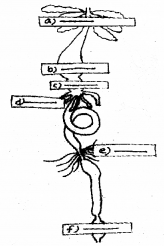
Answer:
a) Salivary gland
b) Crop
c) Gizzard
d) Hepatic caecae
e) Malphigian tubule
f) Rectum
Question 2.
Analyze the circulatory system of the animal. (SAY-2010)
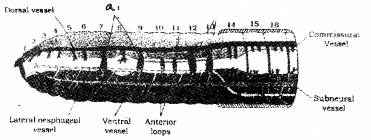
a) Label the part marked as a1
b) Compare it with the circulatory system of cockroach. Which one according to you is more ad-vanced?
Answer:
a) lateral heart
b) cockroach-Blood vascular system of cockroach is an open type Ciculatory system of earth worm is more ad-vanced than cockroach
Question 3.
Observe the diagram given below: (SAY-2010)

a) Identify and write the peculiarity of the system.
b) Label the parts marked as a1 and b1
Answer:
a) Male reproductive system
Male reproductive organs consist of a pair of yellowish ovoid testes, which are found adhered to the upper part of kidneys by a double fold of peritoneum called mesorchium.
b) a1) Urino genital duct b1)Cloaca
Question 4.
The male and female cockroaches can be identified by the difference in their morphological features. (SAY-2010)
a) Name this phenomenon
b) Give one external difference between males and females.
Answer:
a) Sexual dimorphism
b) Males have pair of anal styles on their abdomen. In females anal style is absent.
Question 5.
Arrange the following words into two groups and give and appropriate heading to each group. (MARCH-2011)
Testes, oviduct, cloaca, Bidder’s canal, ovaries, urinogenital duct, vasa efferentia, cloaca.
Answer:
| Male Reproductive system of Frog | Female reproductive System of frog |
| Testes | Ovaries |
| Vasa efferentia | Oviduct |
| Bidder’s canal | Cloaca |
| Urinogenital duct cloaca |
Question 6.
Observe the following figure. No need to redraw the diagram. (MARCH-2011)

a) Label the parts, A and B.
b) Write the function of ‘B’.
Answer:
a) (i) Nucleus
(ii) Intercalated disc.
b) Allow the cells to contract as a unit by passing the signals to adjacent cells.
Question 7.
Identify the following tissues. (SAY-2011)
a) Tissue that conducts impulses.
b) Tissue which stores fat
c) Tissue that connects muscle and bone
d) Tissue that connects bones together
Answer:
a) Nerve tissue
b) adipose tissue
c) Tendons
d) Ligaments
Question 8.
Cell junctions are the most important parts of the animal tissues. (SAY-2011)
a) Write any two types of cell junctions.
b) Mention their function.
Answer:
a) Tight junction and Adhering junction
b) Tight junctions help to stop substances from leaking across a tissue.
Adhering junctions perform cementing to keep neighbouring cells together
Question 9.
Facts related to two types of tissues are given below. Arrange them in two columns by giving suitable headings. Mention the location of each tissue in the human body. (MARCH-2012)
A sheath of tough connective tissue
Striations absent
Bundled together in a parallel fashion
Fusiform shape
Involuntary in function
Striated appearance
Answer:
| Striated | Non-striated |
| A Sheath of tough connective tissue Bundled together in a parallel fashion Striated appearance | Striations absent Fusiform shape Involuntary in function |
Question 10.
The structural and functional abilities of earthworms are helpful for it to become ‘friends of farmers’. Evaluate this statement and substantiate your answer. (SAY-2012)
Answer:
Structural feature
The mouth parts leads to gizzard which help in the griding of soil particles and decaying leaves.
Functional feature
It helps in respiration and penetration of developing roots. It also helps to increase the fertility of soil.
Question 11.
Observe the schematic diagram of a tissue. (SAY-2012)
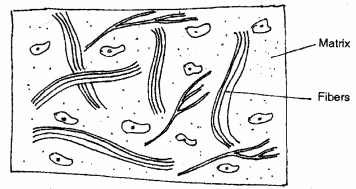
a) Identify the type of the tissue.
b) The fibers in this tissue help the tissue to perfom its function. Substantiate.
Answer:
a) Connective tissue orareolartissue.
b) Fibers provide strength
Question 12.
a) Arrange the following organs in the antero-posteral order of the earthworm body : (MARCH-2013)
Intestinal caeca, gizzard, blood glands, testes, ovary, clitellum
b) Vermicomposting is an advanced strategy in agriculture. What capabilities of the earthworm are utilized in this strategy?
Answer:
a) blood glands-gizzzard-testis-ovary-clitellum-intes- tinal caeca
b) Burrows in the soil makes it porous and worm casting
Question 13.
Features of a particular tissue visible through a mi-croscopic observation is presented here : (SAY-2013)
Cells are closely arranged.
Intercellular matrix absent.
Cells are supported by basement membrane.
a) Identify the animal tissue.
b) Classify this tissue based on the number of cell layers.
c) Mention their functions.
Answer:
a) Epithelial tissue
b) Simple epithelium and compound epithelium
c) It functions as a lining or covering for body cavities, ducts and tubes
Question 14.
Observe the diagrammatic representation. (SAY-2013)
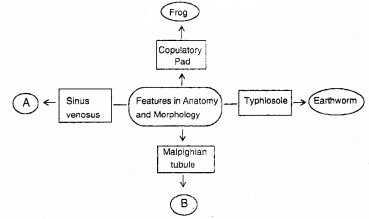
a) Name the animal A and B.
b) Write one function of any two structures given in the boxes.
Answer:
a) A — Frog B — Insect
b) Malpigian tubule — Excretory organ
Typhlosole — Increase effective area of absorption in intestine
Copulatory pad — It helps in copulation
Question 15.
Where do you find the following structures in a human body? (MARCH-2014)
a) Collagen fibres
b) Axons
c) Squamous epithelium
d) Smooth muscles
Answer:
a) Connective tissue or cartilage
b) Neuron or Nerve fibre
c) Lung alveoli or blood vessel
d) Viscera or internal organs
Question 16.
Fill in the blanks with suitable terms according to the indicators shown below : (MARCH-2014)
Indicators: a and b – food habit / c and d – Excretory organ
a) Cockroach : …………
b) Earthworm : ……….
c) Cockroach : ………..
d) Earthworm : ……..
Answer:
a) Omnivore
b) Detrivore
c) Malphigian tubule
d) Nephridia
Question 17.
Name of two animal tissues are given: (MARCH-2014)
a) Cardiac muscle tissue
b) Adipose tissue
i) Write the location of these tissues in our body
ii) Select an accurate character of each tissue from the items given below.
1) Cells of this tissue are specialized to store fat.
2) Cells of this tissue (chondrocytes) are seen in small cavities within the matrix.
3) Presence of intercalated discs.
Answer:
i) a) Cardiac muscle tissue – It is the contractile tissue present only in the heart.
b) Adipose tissue – It is located mainly beneath the skin.
ii) 1. adipose tissue – cells of this tissue are specialised to store fat
Question 18.
Mention the function of the following : (SAY-2014)
a) Blood glands of‘Pheretima’
b) Hepatic caeca of ‘Periplaneta americana’.
Answer:
Blood glands are present on the 4th, 5th and 6th segments. They produce blood cells and haemoglobin which is dissolved in blood plasma. Hepatic caeca or gastric caecae is present at the junction of foregut and midgut, which secrete digestive juice.
Question 19.
If the head of a cockroach is cut off, it will be alive for as long as one week. Give clarification for this statement. (MARCH-2015)
Answer:
The nervous system of cockroach is spread throughout the body. TheJjfcad holds a bit of a nervous system while the rest is situated along the ventral part of its body. So if the head of a cockroach is cut off, it will still live for as long as one week.
Question 20.
The diagram given below is a simple epithelium. (MARCH-2015)
a) Name the part marked as “P” in the figure.
b) Write one function of a simple epithelium.
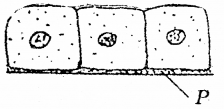
Answer:
a) Cell membrane (Out of syllabus)
b) They are found in the walls of blood vessels and air sacs of lungs and are involved in a function diffusion.
Question 21.
Select the odd one out in the following series. (SAY-2015)
a) Areolartissue; Blood; Neuron; tendon
b) Hypopharynx: Malpighian tubules; Maxillae; Labrum
Answer:
a) Neuron
b) Malphigian tubules
Question 22.
In a laboratory session your Biology teacher exhibited blood smears (slides) of cockroach and human beings under microscope. How will you distinguish them based on the nature of plasma and blood cells? (SAY-2015)
Answer:
The blood of cockroach (haemolymph) is composed of colourless plasma and haemocytes.
In humans blood is a special connective tissue consisting of a fluid matrix, plasma, and formed elements.Blood contains pigment called haemoglobin.
Question 23.
Observe the following chart and answer the given questions: (MARCH-2016)
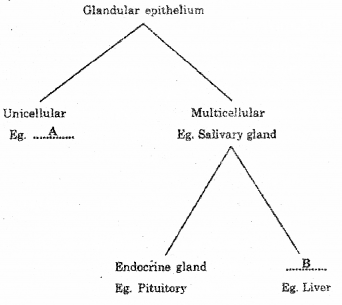
Fill in the missing words A and B.
Answer:
A-Goblet cell
B- Exocrine gland
Question 24.
a) Identify the given diagrams of connective tissues A and B (SAY-2016)
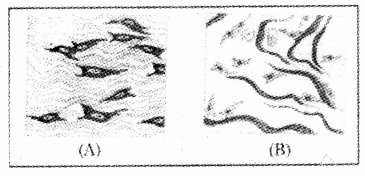
Write the location of tissue B in human body.
Answer:
a) A – Dense regular connective tissue
B – Dense irregular connective tissue
b) Skin
Question 25.
Prepare two correctly matched pairs form the given terms. (SAY-2016)
Ommatidia
Hepatic caecae
Genital pouch
Sense organ
Excretory organ
Digestive gland
Upper lip
Answer:
Ommatidia – sense organ
Hepatic caecae – Digestive gland
Question 26.
In cockroach, spiracles are present in (MARCH-2017)
i) Alimentary canal
ii) Tracheal System
iii) Malpighian tubules
iv) Reproductive system
Answer:
ii) Tracheal System
Question 27.
Complete the given branching diagram based on connective tissue. (MARCH-2017)

Answer:
A – Specialised Connective Tissue
B – Adipose Tissue
C – Irregular
D – Cartilage
